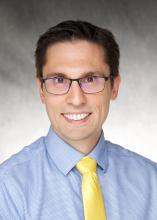Introduction
The overarching theme of our research is to identify novel ways of improving the therapeutic index of chemoradiotherapy; i.e. improving treatment the efficacy of chemoradiation and/or minimizing its toxicity. We have two primary projects we are currently pursuing:
In the first, we are determining if combination therapy with high dose radiation, PARP inhibition, and anti-PD-1 antibodies can stimulate adaptive antitumor immunity in microsatellite stable and mutated syngeneic models of colorectal cancer. Most human colorectal tumors are resistant to anti-PD-1 monotherapy. High dose radiation and PARP inhibitors modulate the immunophenotype of human tumors by distinct and potentially complimentary mechanisms of action. PARP inhibitors are also potent radiosensitizers which enhance the cellular effects of radiation in tumors. We hypothesize that their concurrent use might be exploited to overcome resistant to anti-PD-1 therapies in colorectal tumors. We have shown that radiation dose-dependently increases MHC-1 antigen presentation, PD-L1 surface localization, and inflammatory cytokine signaling in CT26 and MC38 tumor models in vitro and that pretreatment with the PARP inhibitor veliparib significantly increases these effects in both tumor models. In vivo, triple therapy enhanced tumor growth delay longer than all other combinations in both tumor models. We used CD8 T-cell depletion to confirm the enhanced efficacy of combination therapy is immune mediated. We are building on these results by determining if combination therapy stimulates clonal expansion of tumor-targeting T-cells, reduces the percentage of immunosuppressive cell populations in the tumor microenvironment, and promotes regression of distant tumors outside of the radiation field. We are also actively assessing the clinical potential of this approach in a phase 1B/2 clinical trial of patients with locally advanced rectal cancer treated with preoperative short course hypofractionated radiation, niraparib (a novel PARP inhibitor), and dostarlimab (a novel anti-PD-1 antibody).
Our laboratory is also very interested in the development of pharmacologic (high dose) ascorbate as a tissue-selective radiosensitizer in tumors and radioprotector in normal tissues. The clinical and preclinical development of pharmacologic ascorbate has been a collaborative, multi-investigator collaboration between researches in radiation oncology, clinical oncology, neurosurgery, surgical oncology, pathology, radiology, cancer biology, and free radical and radiation biology. Several groups, including our own, have shown that pharmacologic ascorbate selectively sensitizes a variety of tumor models to chemotherapy and radiation by exploiting dysregulated mitochondrial metabolism and redox homeostasis in tumors. Under normal physiologic conditions, ascorbate is a potent donor antioxidant that limits damage caused by oxidative stressors like chemotherapy and radiation. However, tumor cells have relatively high levels of intracellular oxidants and limited buffering capacity against additional oxidative stressors. Rather than functioning as an antioxidant, in tumors ascorbate is rapidly converted to dehydroascorbate (which is a potent oxidant) and stimulates a toxic hydrogen peroxide flux. Our primary interest in pharmacologic ascorbate is determining if it can be exploited to enhance the therapeutic index of DNA repair inhibitor-based chemoradiation. Inhibitors of key DNA repair molecules like ATM and ATR are among the most potent radiosensitizing compounds identified but their clinical utility with radiation has been limited because their radiosensitizing effects are not specific to tumors. Gains in tumor efficacy are offset by increased normal tissue toxicity. We hypothesize that pharmacologic ascorbate could improve the clinical translation of DNA repair inhibitor-based chemoradiation by simultaneously enhancing the efficacy of treatment and simultaneously reducing toxic effects in normal tissues including the bowel. We have shown that pharmacologic ascorbate enhances the radiosensitizing effect of PARP, ATM, and ATR inhibitors in several human and murine colorectal tumor models. We confirmed that this enhancement is peroxide mediated using cells expressing inducible catalase expression. In addition to increasing the number of double strand DNA breaks, we found that pharmacologic ascorbate abrogates activation of the G2 cell cycle checkpoint by radiation by causing cytosolic translocation of ATM in tumors in a peroxide dependent manner. In contrast to tumors, pharmacologic ascorbate increased survival of cultured human colonic epithelial cells exposed to radiation and significantly decreased pathologic markers of radiation injury in the bowel of animals treated with whole abdominal radiation. In our current studies, we aim to determine if selective radioprotection in normal tissues is mediated by inhibition of TGF-β signaling cascades by reactive oxygen species. We are also determining if the protective effects of ascorbate can be further enhanced with the SOD mimetic GC1449.
Joseph Caster

I am a radiation oncologist that specializes in the treatment of gastrointestinal and gynecologic cancers. I earned a Bachelor of Science in biochemistry from Florida State, a PhD in Pharmacology and Cancer biology at Duke University, and then obtained my MD and specialty training in radiation oncology at the University of North Carolina. My primary goal is to bridge my interests in experimental pharmacology and clinical oncology to identify novel treatments to improve outcomes for cancer patients. I have a particular interest in figuring out how to reduce normal tissue complications without sacrificing therapeutic efficacy. Many common cancers readily curable but the cost of therapy can be high: side effects often have a lifelong impact on quality of life and physical function. Advanced imaging techniques, improved radiation delivery, and novel tissue-selective radioprotectors all have the potential to decrease the unintended effects of chemotherapy and radiation in adjacent normal tissues. I strive to foster a collaborative environment for students and trainees to gain experience with basic science and translational research endeavors. Outside of work I am an avid fan of college sports, golf, bowling, fishing, running, cooking, and gardening/landscaping. My wife and I have two dogs (a lab and a dachshund) that somehow got the idea they are entitled little people.